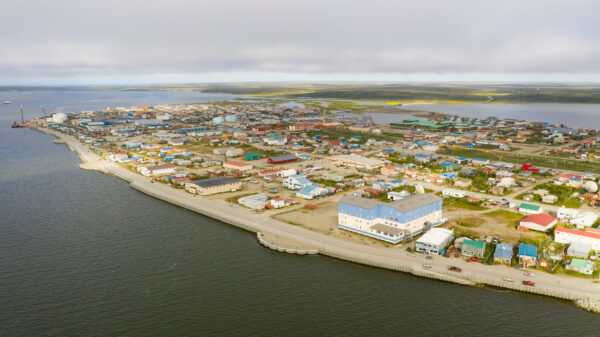
RCAC Helps Kotzebue Navigate Arctic Water Crises
KOTZEBUE, Alaska — After weeks of punishing Arctic temperatures in the winter of 2024, residents served by the Swan Lake Water Loop in Kotzebue, Alaska, met a harsh reality: their water had stopped running. For this predominantly Iñupiat community of 3,100 situated on a narrow sand spit above the Arctic Circle, it was the second major water crisis in less than a year.
The first emergency began in late 2022, when anaerobic bacteria—a bacteria that does not cause health problems—infiltrated the pipeline from Devil’s Lake, Kotzebue’s primary water source. Iron and manganese levels rose, clogging filters just as the city was bringing its new water treatment plant online.
Before that situation could be fully resolved, back-to-back blizzards in March 2023 buried the town under historic snowfall, knocking out power across the community. With electricity down, the water treatment plant’s pumps stopped—a vulnerability made worse because the backup generator had not yet been installed at the new facility.
Then came the Swan Lake Water Loop crisis. The emergency began on Feb. 5, 2024, when an extreme cold period caused the water main and many service lines to freeze. This disruption cut water service to approximately 190 homes. Some households went without running water for almost two months before their service line was thawed.
“Once a water main freezes, all the services connected to the main can freeze too,” explained Greg Magee, a Small Utility Engineering Consultant with the Rural Community Assistance Corporation (RCAC) who has over three decades of experience working in Alaska on rural water systems. “That’s tough.”
Throughout both emergencies, community members demonstrated remarkable adaptability. During the Swan Lake Loop freeze, the city provided bottled water and access to a watering point at the water treatment plant. Many resorted to getting water from neighbors who were not affected or from cutting and melting lake ice for basic household needs. Local schools opened locker rooms so residents could shower.
“They’re determined,” said Magee. “One disaster after another, and they just came back fighting.”
The crisis drained the city coffers. The price tag for temporary repairs to the plant amounted to nearly $100,000 and a whopping $1.35 million to fix the Swan Lake Loop. However, a full replacement of the loop would cost up to $30 million. With limited funds available, city officials declared a local emergency and successfully secured additional disaster declarations from both borough and state governments.
For help navigating the complex world of federal disaster assistance, Kotzebue turned to RCAC. Magee helped the city apply for two grants through the United States Department of Agriculture’s (USDA) Emergency Community Water Assistance Grant (ECWAG) program, which provides up to $150,000 to help rural communities recover from drinking water emergencies.
“ECWAG can only cover part of the costs, but every bit helps,” Magee noted. “Small villages don’t have a lot of revenue sources — primarily state revenue sharing funds and maybe a sales tax.”
With RCAC’s guidance, Kotzebue submitted two grant applications in November 2024: $99,242 to reimburse the treatment plant repairs and $150,000 toward the $1.35 million cost to thaw the Swan Lake Loop. Both applications are still under review by USDA Rural Development and pending final approval.
Throughout remote Alaska, communities like Kotzebue struggle with similar infrastructure challenges: water systems constructed decades ago now showing their age, all while battling some of the harshest weather conditions in North America. In the case of the Swan Lake Water Loop, engineers had already identified vulnerabilities and were designing improvements, but the extreme cold struck before these upgrades could be put in place.
Kotzebue continues to face water quality challenges. In February 2025, the city issued a public notice about elevated manganese levels related to the original Devil’s Lake contamination. Meanwhile, a full replacement of the Swan Lake Loop is estimated at $30 million—funding the community will need significant outside assistance to secure.
Despite these challenges, Kotzebue continues its efforts to rebuild. The town has already secured capital funds for permanent repairs to the water treatment plant. Local contractors supported public works teams during the crisis, demonstrating the community’s self-reliance when facing overwhelming challenges.
Yet local ingenuity alone is not enough. Without support from the Rural Community Assistance Partnership (RCAP) network, communities like Kotzebue would face significant hurdles in accessing federal funding. The complex application process for USDA programs requires expertise that small communities often lack, especially when local staff are already managing emergency repairs and maintaining essential services. As RCAP’s western regional partner, RCAC has played a crucial role in helping Kotzebue navigate these waters and secure the funding necessary to rebuild and strengthen its water infrastructure.
Across rural Alaska, towns continue managing with infrastructure that was built decades ago, all while facing increasingly extreme weather conditions. For communities with limited resources, securing funding is about more than just fixing what is broken—it’s about survival.
“It’s a continuous process,” Magee said, reflecting on his decades of work with Alaska communities, “One step at a time, that’s how these systems eventually get repaired and replaced.”
This article is funded by USDA under RCAP’s Technitrain 2024-2025 grant.

Challenges of a Tribal City: Eagle Butte, SD
State recognized municipalities located within Tribal boundaries can sometimes have unique challenges not seen in a typical small town. The incorporated city of Eagle Butte, South Dakota (population 1,258, of which 88% are American Indian) is the home of the Cheyenne River Sioux Tribe (CRST) Tribal headquarters and lies inside the boundaries of this Tribal nation. The CRST reservation was created in 1889 by the breakup of the Great Sioux Reservation with four of the seven Lakota bands. The reservation is located in north central South Dakota and covers almost all of Dewey and Ziebach Counties. The total land area is 4,266,987 square miles, making it the fourth largest Tribal-owned land area in the United States.
Before the CRST created their own utility, any Tribal-paid improvements made to utilities inside city limits were transferred to the city to maintain. Around 2014, the CRST created the Mni Wašté Water Company and started handling their own wastewater operations and maintenance for the Reservation. As a result, the question of ownership came into play for prior improvements and maintenance to the aging system and who was responsible for future repairs and replacements. With those unanswered questions, there was potential for conflict. For example, at one point in time, one entity hired a contractor to inspect the sewer lines with a camera, resulting in the other entity issuing a cease-and-desist order through their legal counsel. Although the video confirmed that the gravity sewer infrastructure needed repairs and replacements, which was already obvious due to the known collapsed non-working sewer lines, the situation has become contentious because there are two utilities vying for the utility revenue.
The Cheyenne River Sioux Tribe Long Term Group (CRSTLTG) contacted Midwest Assistance Program (MAP) to request their assistance in getting their Tribe and Eagle Butte back on track to make necessary improvements to their infrastructure. Initially, MAP identified possible funding to fix these issues: the State Revolving Loan Fund (SRF), the United States Department of Agriculture Rural Development (USDA-RD), and/or the Indian Health Services (IHS). However, until ownership could be determined, it was impossible to know which entity applies for and manages the funds, since only one utility can apply for and receive funds with the approval of the other entity.
The first thing MAP did was identify all the players and convened a meeting that included representatives from the city of Eagle Butte, CRST, CRSTLTG, USDA-RD, IHS, the Planning District, and the city’s engineering firm. SRF representatives had removed themselves from the discussion, recognizing that Eagle Butte could obtain more grant funds through USDA-RD, considering their Tribal status and that their median household income (MHI) was below 60% of the state’s average. Dialogue could now resume between all the parties to ensure the repairs were made to the systems.
MAP then started helping the city with the USDA-RD application, while simultaneously providing on-site training to the new finance officer. MAP drafted a letter of support from the city to the CRST, asking for their support for the improvements. If support was granted, the city would receive an additional 10% in USDA-RD grant funding, but the CRST has yet to sign the letter.
Despite these setbacks, these entities are all in dialogue to uncover solutions for their utility issues, with MAP’s assistance. As a result, the engineering firm initiated planning and worked on gathering cost estimates, while USDA-RD reopened the old applications. The CRSTLTG is grateful for MAP’s assistance and remains positive that the two entities can work out their differences for the good of their community.
“Your commitment has had a profound impact on our community, and we deeply appreciate the care and attention you’ve shown throughout this process. Your efforts have not only addressed our immediate needs but have also laid the foundation for a stronger, more resilient future for our community.” – Art Rave, Cheyenne River Sioux Tribe Long Term Group
MAP will continue to provide assistance for a long-term solution for the residents of Eagle Butte and the Cheyenne River Sioux Tribe.
This article was funded under RCAP’s EPA Treatment Works 3 – Tribal 23 – 26 grant.
Removing Arsenic from A Tribal School’s Water System
Location: Second Mesa, Arizona
Issue: Second Mesa Day School’s existing arsenic removal system was non-functional and the school’s water system had arsenic levels of 18ppb, exceeding EPA’s maximum contaminant level (MCL)
Outcome: RCAC staff assisted the system operator to troubleshoot the system and bring it back into compliance with arsenic levels below the MCL
Second Mesa Day School is a K-6 elementary school on the Hopi Reservation in northern Arizona. The school has its own water system that the U.S. Environmental Protection Agency (EPA) considers as a community water system. It serves 376 people (students, staff, and teacher housing). The system uses groundwater from an aquifer that has elevated arsenic levels.
To mitigate the situation, the school installed an arsenic removal plant in 2008. The plant’s arsenic removal system has components that need to be routinely maintained, calibrated, and replaced. The system had not received the requisite maintenance for 10 years, and when RCAC arrived in March 2017, it was out of compliance with EPA’s Arsenic Rule.
RCAC worked very closely with the newly hired system operator, Melvin Pooyouma. The plant is relatively complex with several automated pieces that need to be working correctly and in harmony for effective arsenic removal. Starting at the upstream end of the system, the team began to explore and troubleshoot each component down the line.
During the next three months, RCAC and the operator were able to diagnose and fix the system’s broken components. RCAC helped the operator bring the pH to 7.0 and trained the team on the importance of keeping the pH near 7.0.
The second major improvement to the system was removal and inspection of the filter cartridges. The team repaired and reset all the cartridges.
Finally, the team replaced the calcium chloride injection pump that was no longer working and set the pumping rate to the newly calculated correct rate.
The plant now has non-detect levels of arsenic in its treated water and the system can provide safe drinking water to the students and staff.